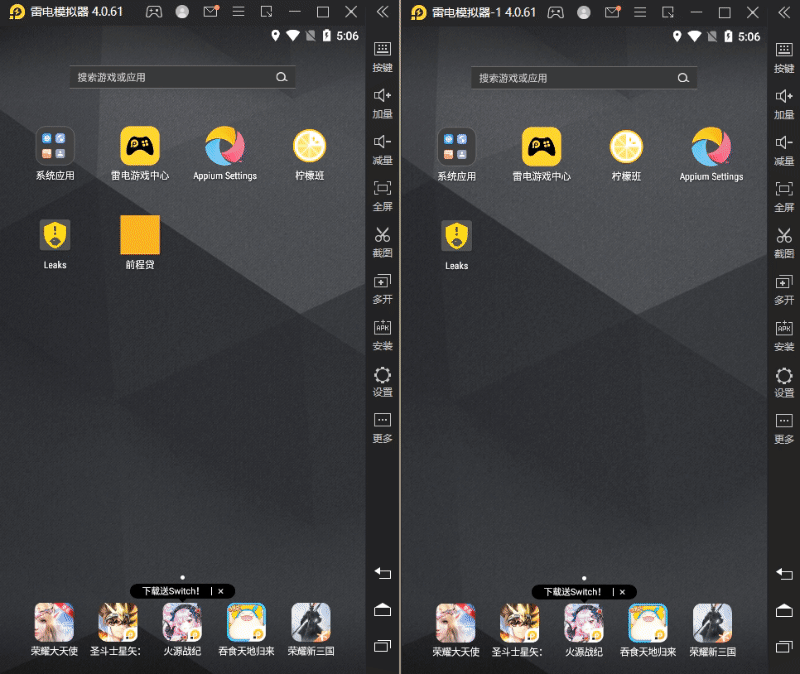 Appium 多设备运行
Appium 多设备运行
# Appium多设备运行
# appium 自动化测试并发执行用例
在网上有很多关于 appium 并发执行自动化测试用例的文章,但是很少有在实际工作场景中正确运行起来的。
先看一下在 youtube 上播放很高的 2 个教学视频:
- https://www.youtube.com/watch?v=QcMCfdE_AmE (opens new window)
- https://www.youtube.com/watch?v=HCe0hu8VMs8 (opens new window)
这两个视频都是兼容性测试,一个用例用两个设备执行。
还有国内其他的教程,只是上面两个教程的复杂版本。代码变复杂了,但是功能还是兼容性测试。我们来看下这些教程有哪些可以优化的空间。
第一点,有些教程需要根据设备自动启动 appium 服务。大多数的教程通过自己封装命令行的形式启动启动。
class ManageAppiumServer:
def start_appium_server(self,port=4723):
command = "node {0} -p {1} -g {2} " \
"--session-override " \
"--local-timezone " \
"--log-timestamp & ".format(self.server_apth, port, appium_log_path)
subprocess.Popen(command, stdout=subprocess.PIPE, stderr=subprocess.PIPE,shell=True).communicate()
这样其实不利于 appium 服务的管理,有时候你需要判断服务的状态等等操作,在 python 的库中早就已经封装了对应的 AppiumService 类来实现。
from appium.webdriver.appium_service import AppiumService
def start_server():
service = AppiumService()
# 启动
service.start(args=['-p 3723'])
# 判断是否在运行
service.is_running()
# 关闭
service.stop()
第二点,需要手动编写多线程或者多进程程序运行代码。
第三点,需要编写 pytest 命令行配置参数指定 caps 信息运行。
# 多设备单进程兼容测试
我自己通过 pytest-xdist 实现了一个简单版本的兼容性测试。假设现在电脑上连接了 2 台设备,我可以在 fixture 中配置参数,指定 2 台手机的名称,然后通过在 desired_caps 中设置 udid 来指定设备的唯一识别号。
import pytest
from appium.webdriver import Remote
@pytest.fixture(params=['emulator-5554', 'emulator-5556'])
def appium_driver(request):
"""获取 app 的driver"""
desired_caps = dict()
desired_caps['app'] = 'D:\lemon_app_webview_debug.apk'
desired_caps['platformName'] = 'Android'
desired_caps['udid'] = request.param
driver = Remote(desired_capabilities=desired_caps,
command_executor='http://127.0.0.1:4723/wd/hub')
driver.implicitly_wait(10)
yield driver
driver.quit()
这样,每个用例都会使用这两个设备运行一遍。但是现在没有开启并发,所以会先通过第一个设备运行用例,再通过第二个设备运行用例,同时只有一个设备启动。

# 多设备多进程兼容测试
自动化测试的用例,多复制几个,每个用例函数会被执行 2 次, 使用 pytest -n 2 执行用例:
from appium.webdriver.common.mobileby import MobileBy
def test_device1(appium_driver):
"""测试设备"""
appium_driver.find_element(MobileBy.ID, "com.lemon.lemonban:id/navigation_my").click()
appium_driver.find_element(MobileBy.ID, "com.lemon.lemonban:id/fragment_my_lemon_avatar_layout").click()
appium_driver.find_element(MobileBy.ID, "com.lemon.lemonban:id/et_mobile").send_keys('1111')
appium_driver.find_element(MobileBy.ID, "com.lemon.lemonban:id/et_password").send_keys('1111')
appium_driver.find_element(MobileBy.ID, "com.lemon.lemonban:id/btn_login").click()
toast = appium_driver.find_element(MobileBy.XPATH, "//android.widget.Toast")

注意,这种兼容性测试不能和 parametrize 参数化同时使用,因为是同时把一个设备号分配给了多个 worker 执行,这显然是不行的。
# 多设备多进程并发测试
appium 并发测试, 使用 pytest -n 2 执行用例:
devices = ['emulator-5554', 'emulator-5556']
@pytest.fixture
def appium_driver_parallel(worker_id):
"""获取 app 的driver"""
desired_caps = dict()
desired_caps['app'] = 'D:\lemon_app_webview_debug.apk'
desired_caps['platformName'] = 'Android'
index = int(worker_id[2:])
desired_caps['udid'] = devices[index]
driver = Remote(desired_capabilities=desired_caps,
command_executor='http://127.0.0.1:4723/wd/hub')
driver.implicitly_wait(10)
yield driver
driver.quit()
可以直接使用参数化:
import pytest
@pytest.mark.parametrize('data', [111,222,333])
def test_device1(appium_driver_parallel, data):
pass
但是现在的情况是,用户使用的夹具是限定死的,如果用户不想使用并发执行,又需要把所有的夹具都换掉。所以我们用一个统一的夹具,如果用单进程,则默认选择第一个设备,如果是多进程,根据索引获取对应设备。
devices = ['emulator-5554', 'emulator-5556']
@pytest.fixture
def appium_driver(worker_id):
"""获取 app 的driver"""
desired_caps = dict()
desired_caps['app'] = 'D:\lemon_app_webview_debug.apk'
desired_caps['platformName'] = 'Android'
if worker_id == 'master':
# 不使用并发,默认获取第一个设备
desired_caps['udid'] = devices[0]
else:
# 并发,第一个 worker 分配第一个设备
# 第二个 worker 分配第二个设备
index = int(worker_id[2:])
desired_caps['udid'] = devices[index]
driver = Remote(desired_capabilities=desired_caps,
command_executor='http://127.0.0.1:4723/wd/hub')
driver.implicitly_wait(10)
yield driver
driver.quit()
如果没有用 pytest-xdist,会默认选择第一个设备,通过 master 来工作,如果使用 pytest-xdist, 则根据 worker 来分配设备执行,hw0, 使用第一个设备, hw1 使用第二个设备...
这种方式你可以改变夹具的 scope 照样适用。
@pytest.fixture(scope='class')
def appium_driver(worker_id):
...

# 参考
本文完,感谢你的耐心阅读,如有需要可加我微信,备注「博客」并说明原因,我们一起进步,下次见。
